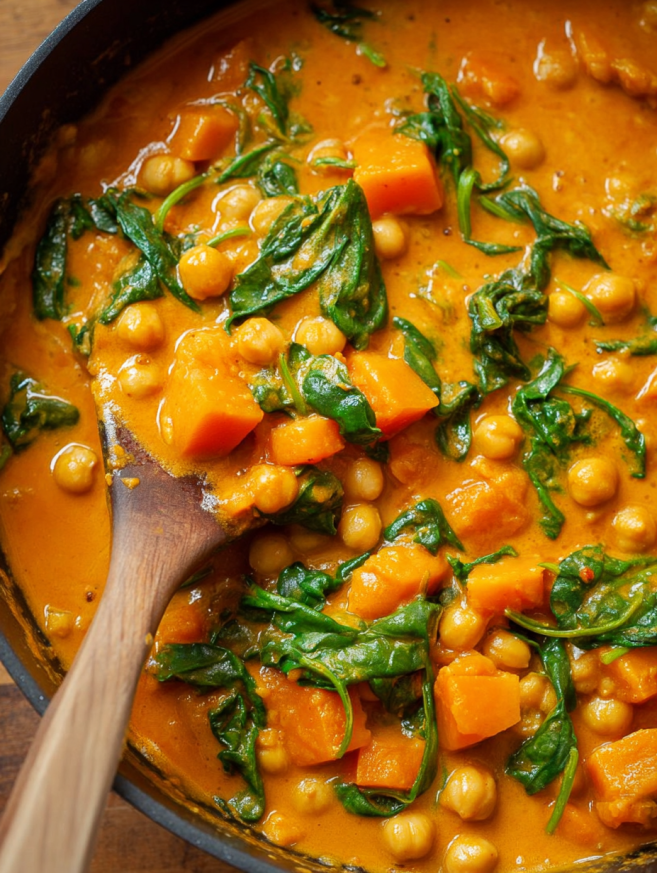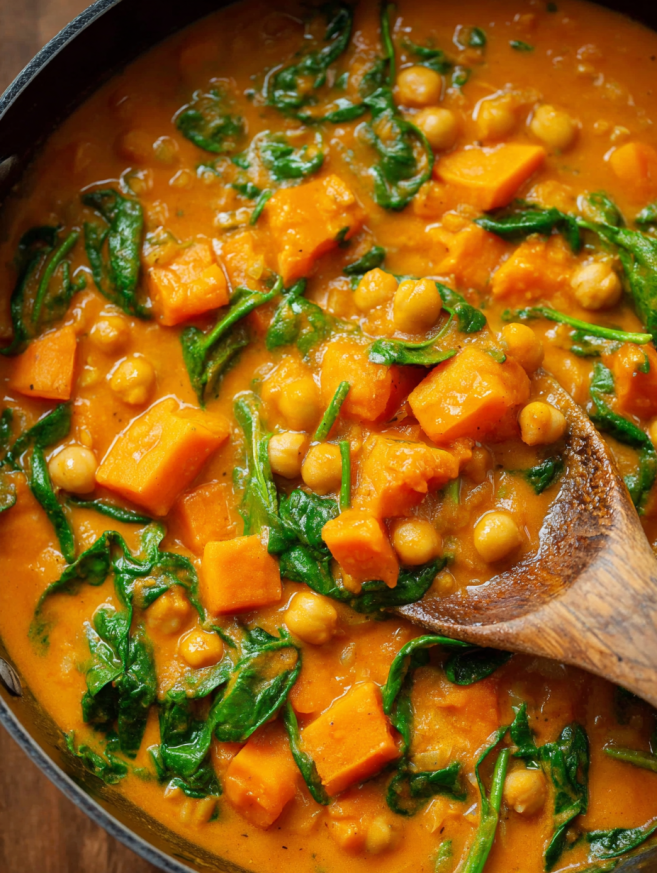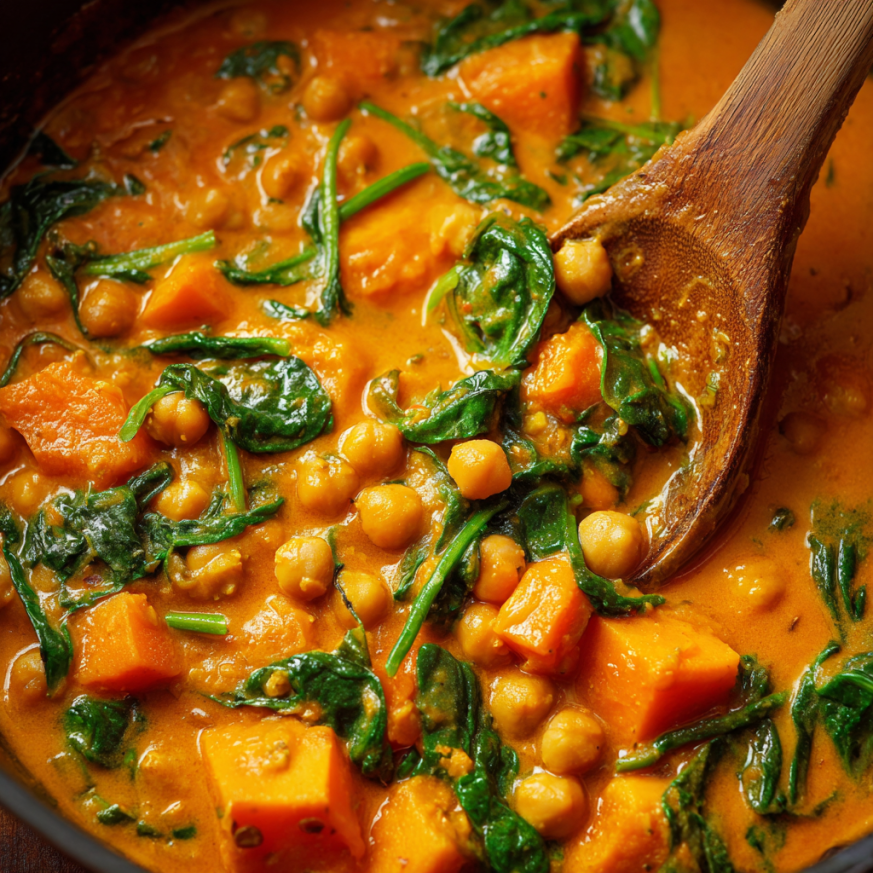When the weather starts to cool and I’m craving something warm and comforting, this chickpea butternut squash curry never fails to deliver. I discovered this recipe during a particularly hectic week when I needed something satisfying but didn’t have hours to spend in the kitchen. What surprised me most was how such simple ingredients could create such complex, restaurant-quality flavors in just 43 minutes.
The creamy coconut milk base paired with the subtle heat of red curry paste creates a perfect harmony that makes this dish incredibly addictive. Each spoonful delivers tender butternut squash, hearty chickpeas, and vibrant spinach in a sauce that’s both rich and light at the same time. It’s become my go-to recipe for impressing guests while keeping my sanity intact during busy weeknights.
Why This Curry Will Become Your New Favorite
Lightning-Fast Preparation
This recipe proves that incredible curry doesn’t require all-day simmering. In under 45 minutes, you’ll have a complete meal that tastes like it took hours to prepare. The streamlined ingredient list means less shopping and chopping, making it perfect for those moments when you want something special without the stress.
Nutritional Powerhouse
Butternut squash provides beta-carotene and fiber, while chickpeas deliver plant-based protein and additional fiber. Meanwhile, the spinach adds iron and vitamins, creating a well-rounded meal that nourishes your body. The coconut milk contributes healthy fats that help with nutrient absorption.
Naturally Vegan and Gluten-Free
This curry naturally accommodates various dietary preferences without sacrificing flavor. Whether you’re cooking for vegans, those avoiding gluten, or simply trying to eat more plant-based meals, this recipe satisfies everyone at the table. Additionally, it’s dairy-free while still being incredibly creamy and satisfying.
Budget-Friendly Ingredients
The main components are affordable pantry staples and seasonal vegetables. Canned coconut milk and chickpeas are economical protein sources, while butternut squash is typically inexpensive and goes a long way. Furthermore, this recipe makes generous portions that provide excellent leftovers.
Essential Ingredients
Aromatic Base
- 1 tablespoon canola oil – neutral cooking oil
- 1 onion, diced – sweet foundation
- 2 garlic cloves, minced – aromatic depth
- 1 tablespoon minced ginger – warming spice
- 3 tablespoons red curry paste – flavor concentrate
- 1 teaspoon salt, divided – seasoning enhancement
Creamy Foundation
- 2 cans coconut milk – rich, creamy base
- ½ butternut squash, peeled and cubed – natural sweetness (about 4 cups)
- 1 can chickpeas, drained and rinsed – protein and texture
Fresh Finishing Touches
- 3 cups packed baby spinach – nutrient-dense greens
- 1 lime, juice only – bright acidity
Step-by-Step Instructions
Building the Flavor Foundation
Heat the canola oil in a large pot over medium heat. Add the diced onion and cook until it becomes translucent and softened, approximately 5 minutes. The onion should be golden and fragrant, not browned. Next, stir in the minced garlic, ginger, red curry paste, and half a teaspoon of salt. Cook this aromatic mixture for another minute until the spices become fragrant and the curry paste darkens slightly.
Creating the Creamy Base
Pour in both cans of coconut milk, stirring thoroughly to combine with the aromatic base. Make sure to scrape up any bits from the bottom of the pot, as these add incredible flavor to your curry. The mixture should be smooth and well-incorporated, with no lumps of curry paste remaining.
Adding the Main Components
Add the cubed butternut squash, drained chickpeas, and the remaining salt to the pot. Bring the mixture to a gentle boil, then reduce the heat to maintain a steady simmer. Cook uncovered for 20 minutes, stirring occasionally, until the butternut squash is fork-tender and the flavors have melded together beautifully.
Final Touches
Stir in the baby spinach and cook just until it wilts, about 2 minutes. The spinach should be bright green and tender. Finally, finish with a generous squeeze of fresh lime juice, which brightens the entire dish and balances the rich coconut milk.

Serving Suggestions
Perfect Pairings
This curry shines when served over fluffy jasmine rice or basmati rice, which soaks up the delicious sauce perfectly. Brown rice adds a nutty flavor and additional fiber, while cauliflower rice provides a lower-carb alternative that still complements the curry beautifully.
Garnish Options
Fresh cilantro leaves add a pop of color and herbaceous freshness that contrasts wonderfully with the rich curry. Toasted coconut flakes provide textural interest, while sliced green onions add a mild onion flavor and visual appeal.
Bread Accompaniments
Warm naan bread or pita make excellent vehicles for scooping up every last bit of sauce. For a lighter option, serve with papadums or crispy flatbread that won’t compete with the curry’s complex flavors.
Additional Enhancements
A dollop of Greek yogurt or coconut yogurt adds cooling contrast to the curry’s warmth. Crushed peanuts or cashews provide crunch and richness that elevates the entire experience.
Recipe Variations
Protein Additions
While this curry is satisfying on its own, you can easily add protein. Cubed tofu, tempeh, or cooked chicken work wonderfully. Add firmer proteins like tofu during the simmering stage, while pre-cooked proteins should be stirred in during the last few minutes.
Vegetable Swaps
Sweet potatoes make an excellent substitute for butternut squash, providing similar sweetness and texture. Other vegetables like cauliflower, bell peppers, or green beans can be added based on your preferences or what’s in season.
Spice Level Adjustments
For milder curry, reduce the red curry paste to 2 tablespoons and add gradually to taste. Conversely, if you prefer more heat, add a pinch of cayenne pepper or a diced jalapeño with the aromatics.
Seasonal Adaptations
During summer, substitute zucchini for butternut squash and add fresh basil instead of spinach. Winter variations might include root vegetables like parsnips or turnips for different flavor profiles.
Make-Ahead Tips
Prep Strategies
The butternut squash can be peeled and cubed up to 2 days ahead, stored in the refrigerator. Similarly, the onion, garlic, and ginger can be prepped and refrigerated in separate containers. This advance preparation reduces cooking time to just 20 minutes.
Storage Guidelines
This curry actually improves in flavor after a day in the refrigerator, making it perfect for meal prep. Store in the refrigerator for up to 4 days, though you may need to add a splash of coconut milk when reheating as it tends to thicken.
Freezer-Friendly Options
The curry freezes beautifully for up to 3 months. However, omit the spinach if freezing, as it doesn’t maintain its texture well. Add fresh spinach when reheating for the best results.
Reheating Tips
Reheat gently on the stovetop over low heat, stirring occasionally. If the curry has thickened too much during storage, thin it with a little coconut milk or vegetable broth to restore the proper consistency.
Notas
Consistency Control: If the curry thickens too much during simmering, stir in a splash of vegetable broth or water to loosen it without diluting the flavor. The final consistency should coat the back of a spoon but still be pourable.
Vegetable Substitutions: Sweet potatoes can replace some or all of the butternut squash for a different flavor profile. They cook at a similar rate and provide comparable sweetness and texture.
Curry Paste Quality: Using high-quality red curry paste makes a significant difference in the final flavor. Look for brands that list recognizable ingredients and avoid those with excessive preservatives.
Coconut Milk Tips: Shake the cans well before opening, as the cream often separates. Using full-fat coconut milk creates the richest, most satisfying curry.

Frequently Asked Questions
Can I make this curry ahead of time? Absolutely! This curry actually tastes better the next day as the flavors have more time to meld. Store it in the refrigerator for up to 4 days, and reheat gently on the stovetop. You might need to add a splash of coconut milk when reheating.
What if I can’t find red curry paste? Red curry paste is available in most grocery stores in the international aisle. However, if unavailable, you can substitute with 2 tablespoons of curry powder mixed with 1 tablespoon of tomato paste, though the flavor will be different.
How can I make this curry less spicy? Start with 2 tablespoons of curry paste instead of 3, and taste before adding more. You can also add a tablespoon of sugar or honey to balance the heat. Serving with yogurt or extra coconut milk also helps cool the spice.
Can I use frozen butternut squash? Yes, frozen butternut squash works well and saves preparation time. Add it directly to the curry without thawing, but you may need to cook for a few extra minutes to ensure it’s tender.
What’s the best way to cut butternut squash? Peel the squash with a vegetable peeler, cut it in half lengthwise, scoop out the seeds, and then cut into 1-inch cubes. This size ensures even cooking and perfect texture in the finished curry.
Can I substitute other greens for spinach? Definitely! Kale, Swiss chard, or bok choy all work well. Heartier greens like kale should be added a few minutes earlier than spinach to ensure proper cooking.
How do I know when the butternut squash is done? The squash should be fork-tender but still hold its shape. It shouldn’t be mushy or falling apart. Testing with a fork after 20 minutes of simmering usually indicates doneness.
Can I make this in a slow cooker? While this recipe is designed for stovetop cooking, you can adapt it for a slow cooker. Sauté the aromatics first, then transfer everything except the spinach to the slow cooker. Cook on low for 4-6 hours, then stir in the spinach during the last 10 minutes.
Nutrition Facts per Serving:
- Calories: 414
- Protein: 11g
- Carbohydrates: 38g
- Fat: 28g
- Fiber: 9g
- Sodium: 992mg
Recipe yields 4 servings | Prep time: 15 minutes | Cook time: 28 minutes | Total time: 43 minutes

